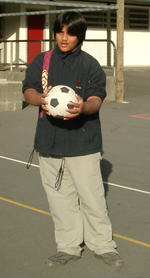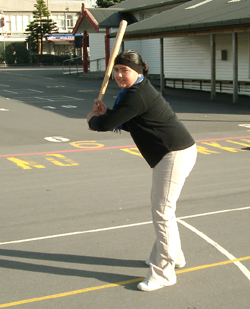|
Although national
monitoring has been designed primarily to present an overall national
picture of student achievement, there is some provision for reporting
on performance differences among subgroups of the sample. Seven demographic
variables are available for creating subgroups, with students divided
into two or three subgroups on each variable, as detailed in Key
Features.
The analyses of the relative performance of subgroups used an overall
score for each task, created by adding scores for the most important components
of the task.
Where only two subgroups were compared, differences in task performance
between the two subgroups were checked for statistical significance using
t-tests. Where three subgroups were compared, one way analysis of variance
was used to check for statistically significant differences among the
three subgroups.
Because the number
of students included in each analysis was quite large (approximately 450),
the statistical tests were quite sensitive to small differences. To reduce
the likelihood of attention being drawn to unimportant differences, the
critical level for statistical significance was set at p = .01 (so that
differences this large or larger among the subgroups would not be expected
by chance in more than one percent of cases). For team tasks, the critical
level was raised to p = .05, because of the smaller sample size (120 teams,
rather than about 450 students).
For the first five of the seven demographic variables discussed, statistically
significant differences among the subgroups were found for less than twenty
percent of the tasks at both year 4 and year 8. For the remaining two
variables, statistically significant differences were found on a substantial
proportion of tasks at one or both levels. In the report below, all “differences”
mentioned are statistically significant differences (to save space, the
words “statistically significant” are omitted).
The performance patterns found were different for the movement skills
tasks (Chapter 4 - Movement Concepts
and Motor Skills) and the other tasks (Chapter 3 (Personal
Health and Physical Development), Chapter 5 (Relationships
with Other People) and Chapter 6 (Healthy
Communities and Environments)). In this chapter (Chapter 4), the former
are referred to as PE (physical education) tasks, the latter as health
tasks.
School size
Results were compared from students in larger, medium sized, and small
schools (exact definitions were given in Key
Features).
For year 4 students, there were no differences on any of the 31 health
tasks or 22 PE tasks, nor on any questions of the two surveys.
For year 8 students, there were no differences on any of the 39 health
tasks or 24 PE tasks, nor on any questions of the two surveys.
School type
Results were compared for year 8 students attending full primary and intermediate
schools. There were no differences between these two subgroups on any
of the 24 PE tasks, nor on any questions of the two
surveys. There were, however, differences on 3 of the 39 health tasks,
with students from full primary schools scoring higher on all three: Body
Parts, Link Task 1,
and Link Task 27.
Community size
Results were compared for students living in communities containing over
100,000 people (main centres), communities containing 10,000 to 100,000
people (provincial towns), and communities containing less than 10,000
people (rural areas).
For year 4 students, there were differences among the three subgroups
on two of the 31 health tasks and two of the 22 PE tasks. Students from
main centres scored lowest on Smoke
Alarm, students from provincial towns scored highest on Link
Task 6, and students from main centres scored highest (with students
from rural areas lowest) on both Tï
Räkau, and Link Task
18. There were no differences on questions of the two
surveys.
 |
For
year 8 students, there were differences among the three subgroups
on two of the 39 health tasks: students from main centres scored lowest
on Link Task 6 but highest
(with students from rural areas lowest) on Whose
Friend?. There was also a difference on one question of the PE
Survey, with students from rural areas lowest on the reported
amount of vigorous physical activity in the last 24 hours (question
9). There were no differences on the 24 PE tasks, nor on questions
of the Health Survey. |
Zone
Results achieved by students from Auckland, the rest of the North Island,
and the South Island were compared.
For year 4 students, there were differences among the three subgroups
on five of the 31 health tasks. Students from Auckland scored lowest on
four tasks: Camp Out, Smoke
Alarm, Link Task 1,
and Link Task 6 , with students
from the South Island highest on the first and third of these. Students
from regions of the North Island other than Auckland scored highest on
Link Task 5. There was also
a difference on one of the 22 PE tasks, with students from Auckland scoring
highest on Link Task 18.
There were no differences on questions of the two
surveys.
For year 8 students, there were differences among the three subgroups
on two of the 39 health tasks. Students from Auckland scored lowest on
both Link Task 6, and To
Smoke or Not to Smoke, with South Island students highest on the latter.
There were also differences on three of the 24 PE tasks, with students
from Auckland highest on Link
Task 12, but lowest on Circuit
Ball and Link Task 18.
There were no differences on questions of the two
surveys.
Student ethnicity
 Results achieved by Mäori and non-Mäori students were compared.
Results achieved by Mäori and non-Mäori students were compared.
For year 4 students, there were differences on 5 of the 28 health tasks,
with Mäori students scoring lower than non-Mäori students on
The Body, Andrew’s
School, Whose Friend?,
Marching Boy, and Link
Task 25. There were differences in the opposite direction on two of
the 22 PE tasks: Mäori students scored higher than non-Mäori
students on Tap ‘n’
Hit and Target Throw.
On the Health Survey, Mäori students
were more positive than non-Mäori students about doing health education
at school (question 1) and about learning or doing more health education
as they got older (question 3). On the PE
Survey, Mäori students were more positive than non-Mäori
students about doing PE at school (question 1).
For year 8 students, there were differences on two of the 36 health tasks,
with Mäori students scoring lower than non-Mäori students on
Stressed Out and Choice
Food. There were differences in the opposite direction on two of the
22 Physical Education tasks: Mäori students scored higher than non-Mäori
students on Tï Räkau
and Link Task 20. There
were no differences on questions of the two
surveys.
Socio-economic index
Schools are categorised by the Ministry of Education based on census data
for the census mesh blocks where children attending the schools live.
The SES index takes into account household income levels, categories of
employment, and the ethnic mix in the census mesh blocks. The SES index
uses ten subdivisions, each containing ten percent of schools (deciles
1 to 10). For our purposes, the bottom three deciles (1-3) formed the
low SES group, the middle four deciles (4-7) formed the medium SES group,
and the top three deciles (8-10) formed the high SES group. Results were
compared for students attending schools in each of these three SES groups.
For year 4 students, there were differences among the three subgroups
on 10 of the 31 health tasks, six in Chapter 3 and four in Chapter 5.
Because of the number of tasks involved, they are not listed here. In
almost every case, students in the low SES schools scored lowest, with
students in medium SES schools substantially higher and students in high
SES schools generally slightly higher still. The pattern was very different
for PE tasks: there was a difference on just one of the 22 tasks, with
students in high SES schools scoring highest on Vertical
Jump. There were no differences on questions of the PE
Survey, but there were differences on two questions of the Health
Survey, with students from low SES schools more positive than students
from higher SES schools about doing health education at school (question
1) and about learning or doing more health education as they got older
(question 3).
For year 8 students, there were differences among the three subgroups
on 17 of the 39 health tasks, twelve in Chapter 3, four in Chapter 5 and
one in Chapter 6. Because of the number of tasks involved, they are not
listed here. In almost every case, students in the low SES schools scored
lowest, with students in medium SES schools substantially higher. In about
half of the cases, students in high SES schools scored higher still. The
pattern was very different for PE tasks: there were differences on just
two of the 24 tasks: Many
Moves and Vertical
Jump, with students in low SES schools scoring lowest on both, and
students in high SES schools doing a little better than students in medium
SES schools. There were no differences on questions of the
two surveys.
 |
Gender
Results achieved by male and female students were compared.
For year 4 students, there were differences between boys and girls
on just three of the 28 health tasks, all from Chapter 5. Girls scored
higher than boys on Andrew’s
School, Marching Boy,
and Link Task 25. The
picture was very different for the PE tasks: there were differences
on 16 of the 22 PE tasks. Boys scored higher on half (11) of the tasks,
all involving running speed, jumping, or the use of balls or similar
objects (throwing, catching, hitting, dribbling). Girls scored higher
on 5 tasks involving precision movement and body control: Ladder
Activities, Forward
Roll, Many Moves,
Link Task 19, and Link
Task 20. There were no differences on questions of the Health
Survey, but there was a difference on one questions of the PE
Survey: girls thought their families were more positive about
their capabilities in PE (question 4). |
For year 8 students,
there were differences between boys and girls on 12 of the 26 health tasks,
five in Chapter 3 and seven in Chapter 5. Girls scored higher than boys
on all 12 tasks. There were also differences on 16 of the 23 PE tasks.
Boys performed better on 10 tasks, three of which involved running fast
or jumping, and seven of which involved the use of balls or similar objects
(throwing, catching, hitting, dribbling). Girls performed better than
boys on six tasks: Ladder
Activities, Forward
Roll, Tï Räkau,
Many Moves, Link
Task 19, and Link Task
20. There was a difference on one question of the
Health Survey, with girls more positive about learning or doing more
health education as they got older (question 3). Finally, there were differences
on four questions of the PE Survey,
with boys more positive about doing PE at school (question 1), how good
they thought they were at PE (question 2), liking to do more PE at school
(question 7), and continuing to learn PE as they got older (question 8).
Summary
School size, school type (full primary or intermediate), community size,
geographic zone and student ethnicity (Mäori/non-Mäori) did
not seem to be important factors predicting achievement in health and
physical education, or attitudes towards them.
Students attending low SES schools scored lower than other students on
32 percent of the health tasks at year 4 level and 44 percent at year
8 level. With PE tasks, however, there were differences involving SES
for less than 10 percent of the tasks at both levels.
Girls performed better than boys on 11 percent of the year 4 health tasks
and 33 percent of the year 8 health tasks. The picture was very different
with PE tasks. At both year levels, boys performed better than girls on
44 to 50 percent of the tasks (most of the tasks that involved running
fast, jumping, throwing, catching, hitting or dribbling balls), while
girls performed better than boys on 23 to 26 percent of the tasks (involving
precision movement and body control).
For physical education tasks, the only notable change between 1998 and
2002 was that in 1998, year 4 students from low SES schools performed
better than their counterparts from higher SES schools on 17 percent of
tasks. That positive disparity was no longer evident in 2002, with students
from low SES schools performing worse on 4 percent of tasks and better
on none.
Comparing the subgroup performance patterns on health tasks in 2002 with
those in 1998, the only notable change has been a reduction in the disparity
of performance between Mäori and non-Mäori year 8 students.
Non-Mäori students performed better than Mäori students on 27
percent of year 8 tasks in 1998, but only on 6 percent in 2002.
|